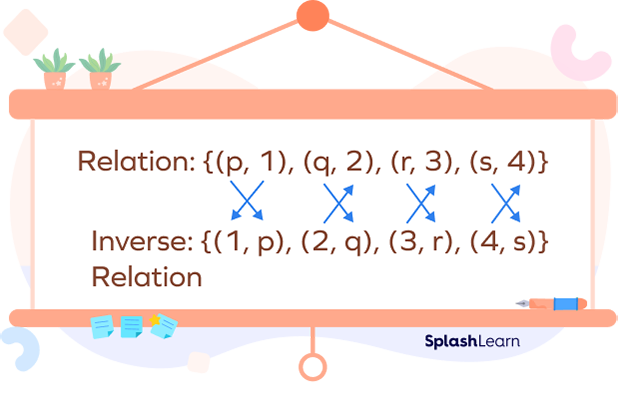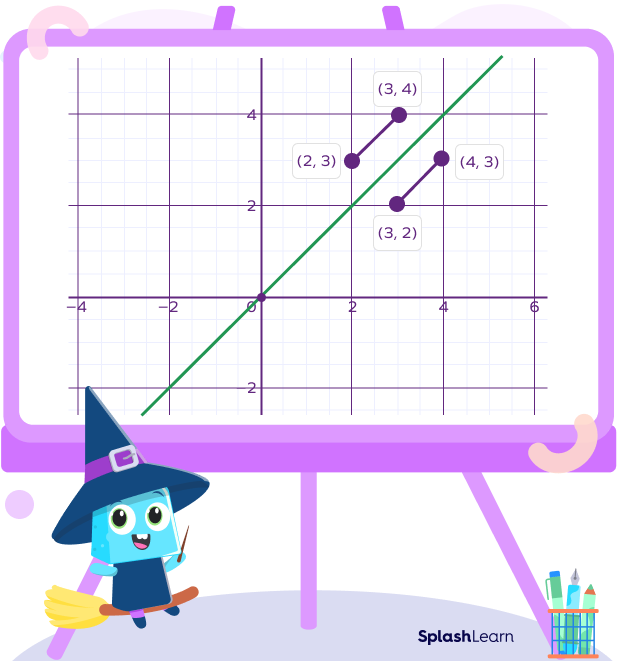What Is Inverse Relation?
An inverse relation is the inverse of a given relation obtained by Interchanging or swapping the elements of each ordered pair. In other words, if (x, y) is a point in a relation R, then (y, x) is an element in the inverse relation R–1.

A relation R from set A to B is a subset of the Cartesian product of A and B. R is a subset of A $ \times$ B. The elements of R of the form of an ordered pair (a, b) where a $\in$ A and b $\in$ B.
The inverse relation of R is denoted by R–1. R–1 is a subset of B $\times$ A. The elements of R–1 of the form of an ordered pair (b, a) where b $\in$ B and a$\in$ A.
Recommended Games
Inverse Relation: Definition
Inverse relation is defined as the relation obtained by interchanging the elements of each ordered pair in the given relation. By swapping the inverse relation’s domain and range, we can write the inverse relation.
If R is a relation given by $R = \left\{(x,\; y): x ∈ A \text{and} y ∈ B\right\}$. then its inverse is given by
$R^{-1} = \left\{(y,\; x): y ∈ B \text{and} x ∈ A\right\}$
If R is a relation from set A to set B, then the inverse relationR–1 is defined from set B to set A. In other words, if $(x,\; y) ∈ R$, then $(y,\; x) ∈ R^{-1}$ and vice versa.
Recommended Worksheets
Inverse Relation Graph
If the graph of a relation is given, its inverse can be found by reflecting it along the line $y = x$. To plot the inverse relation graph follow the following steps:
- On the given graph of a relation, select some points.
- To create new points, swap the x and y coordinates of each point.
- Draw a line connecting all of these new points, to get the graph of the inverse relation.
Let’s see an example of elements of a relation and inverse relation on a graph.

Inverse Relation Theorem
Statement: The inverse relation theorem states that for any relation R, (R–1)–1 = R.
Proof:
Let’s prove the inverse relation statement using the above-mentioned mathematical definition of relation and its inverse.
If (x, y) ∈ R, then (y, x) ∈ R–1 and vice versa.
Let (x, y) ∈ R ⇔ (y, x) ∈ R–1
⇔ (x, y) ∈ (R–1)–1
Every element of R is in (R–1)–1.
Thus, R $\subseteq$ (R–1)–1
Also, following the reverse steps, we get that every element in (R–1)–1 is in R.
Thus, (R–1)–1 $\subseteq$ R
Hence, (R–1)–1 = R.
Inverse of Algebraic Relation
If an algebraic form of a relation is given, such as R $= \left\{(x,\; y): y = ax + b\right\}$.
Then the steps listed below are used to find its inverse.
Step 1: Interchange or swap the variables x and y.
For the given algebraic equation, after interchanging variables, x = ay + b
Step 2: Now express y in terms of x.
Here, x = ay + b
$\Rightarrow ay = x \;-\; b$
$y = \frac{x \;-\; b}{a}$
Step 3: Then write the given algebraic relation’s inverse as
R–1 $= \left\{(x,\; y): y = \frac{x \;-\ b}{a} \right\}$
Note: Check to see if the graphs y = ax + b and $y = \frac{x \;-\; b}{a}$ are symmetric about the line y = x.
Domain and Range of Inverse Relation
The domain and range of a given relation are interchanged when we find the inverse relation.
Domain:
The set of all first elements of the ordered pairs of R is referred to as the domain of a relation. The range of R is then the domain of R–1.
Range:
The set of all the second element sets is referred to as the range of the relation R. The domain of R is then the range of R–1.
Example:
| Relation | Inverse |
|---|---|
| R $= \left\{(2, 4), (4, 16), (6, 36)\right\}$ | R–1 $= \left\{(4, 2), (16, 4), (36, 6)\right\}$ |
| Domain of relation R $= \left\{2,4,6\right\}$. | Domain of relation R $= \left\{4,16,36\right\}$. |
| Range of relation R $= \left\{4,16,36\right\}.$ | Range of relation R $= \left\{2,4,6\right\}$ |
Facts about Inverse Relation
- If R is a symmetric relation, then R = R–1.
- The curves that represent a relation and its inverse on a graph are symmetric around the line y = x.
- Every function is a relation. Not every relation is a function. In a function, each input (domain element) is associated with exactly one output (range element), while in a general relation, an input can be associated with multiple outputs.
- If the original relation has a positive slope, the inverse relation will have a negative slope, and vice versa.
Conclusion
In this article, we have learned the inverse relation definition, their graph, the inverse of algebraic relation, domain, range of inverse relation. Let’s solve a few examples.
Solved Example on Inverse Relation
- Write the inverse of the relation R = {(1, x), (2, y), (3, z)}.
Solution:
R = {(1, x), (2, y), (3, z)}
The inverse of the relation is obtained by interchanging the elements of each ordered pair in a relation.
Hence, $R^{-1}$ = {(x,1),(y,2),(z,3)}.
- Find the domain and range of a relation R = { (x, $x^{3}$): x is an odd number less than 10}.
Solution:
R = { (x, $x^{3}$): x is an odd number less than 10}.
Odd numbers less than 10 are 1, 3, 5, 7, 9.
R = {(1, 13),(3, 33), (5, 53), (7, 73), (9, 93)}
R = {(1, 1), (3, 27), (5, 125), (7, 343), (9, 729)}
Domain of R = {1, 3, 5, 7, 9}
Range of R = {1, 27, 125, 343, 729}
- If a relation is given by R = {(x, y); y = 2x + 3,1$\le x \le$ 4}, the domain and range of its inverse relation.
Solution:
R = {(x, y); y = 2x + 3,$1 \le x \le 4$}
For x = 1, y = 5
For x = 2, y = 7
For x = 3, y = 9
For x = 4, y = 11
R = {(1, 5), (2, 7), (3, 9), (4, 11)}
Hence, R–1 = {(5, 1), (7, 2), (9, 3), (11, 4)}
Domain of R–1 = {1, 2, 3, 4}
Range of R–1 = {5, 7, 9, 11}
Practice Problems on Inverse Relation
Inverse Relation: Definition, Formula, Graph, Facts, Examples, FAQs
The graphs of a relation and its inverse relation are symmetrical along ______.
The graph of inverse relation is symmetrical in y = x.
The domain of an inverse relation $R^{–1}$ = {(0.1, 1), (0.2, 2), (0.3, 3), (0.4, 4), (0.5, 5)}
The set of first elements of all ordered pairs is called domain.
Hence, the domain of $R^{–1}$ = {(0.1, 1), (0.2, 2), (0.3, 3), (0.4, 4), (0.5, 5)} is {0.1, 0.2, 0.3, 0.4, 0.5}
What is the range of the inverse relation of R = {(1, a), (2, b), (3, c), (4, d), (5, e)}?
Given, R = {(1, a), (2, b), (3, c), (4, d), (5, e)}
Inverse relation of R is given by,
$R^{-1} = {(a,1)(b,2),(c,3),(d,4),(e,5)}
The set of second elements of all ordered pairs is called range.
Hence, range={1, 2, 3, 4, 5}
Let $y = \frac{1}{x}$. What is the inverse relation of y?
To find the inverse relation of h, we need to swap the variables x and y and solve for y. So, we start by writing:
$x = \frac{1}{y}$
$y = \frac{1}{x}$
Therefore, the inverse relation of y is $f^{–1}(x) = \frac{1}{x}$.
The range of inverse relation $R^{–1} = {(x,1): x is a natural number less than 7} is____.
$R^{–1}$ = {(x,1): x is a natural number less than 7}
$\Rightarrow R^{–1}$ = {(1,1), (2, 1), (3, 1), (4, 1), (5, 1), (6, 1)}
Range of $R^{–1}$ = {1}
Frequently Asked Questions on Inverse Relation
What is an inverse relation?
An inverse relation of a given relation is a relation where the order of the pairs is reversed. If the set of ordered pairs in the original relation is (a, b), the set of ordered pairs in the inverse relation is (b, a).
What do you mean by the domain of relation?
The domain of a relation is the set that contains all of the first elements of all ordered pairs in the relation R.
What is an empty relation?
An empty relation is one in which there is no relation between any elements of a set.
What is the range of relation?
The set of the second coordinates from the ordered pair in a relation is called range.
What is the symmetric relation?
A relation R defined on the set A is said to be symmetric if (b, a)$\in$ R holds true when (a, b) $\in$ R, for all a and b in A.


















